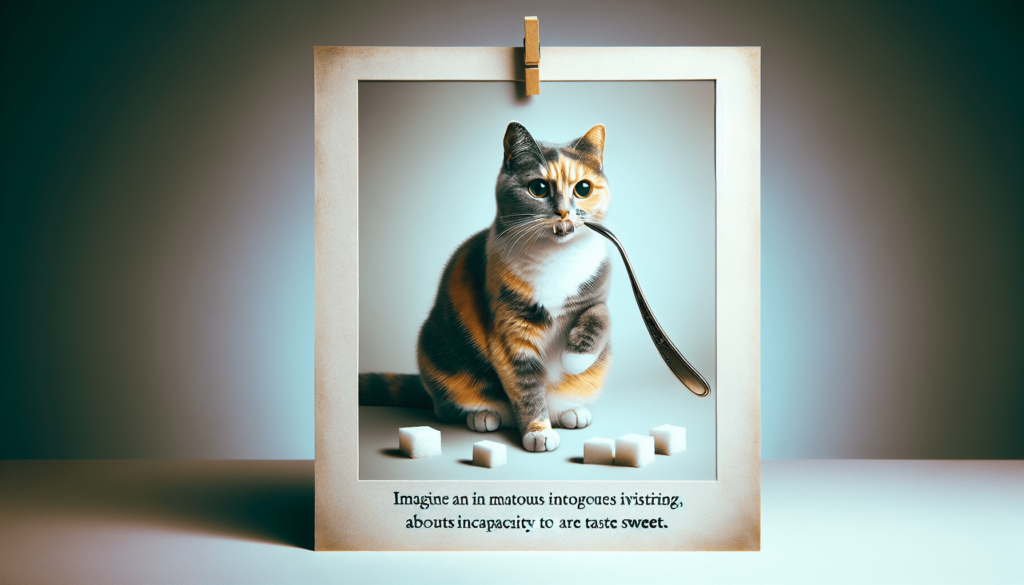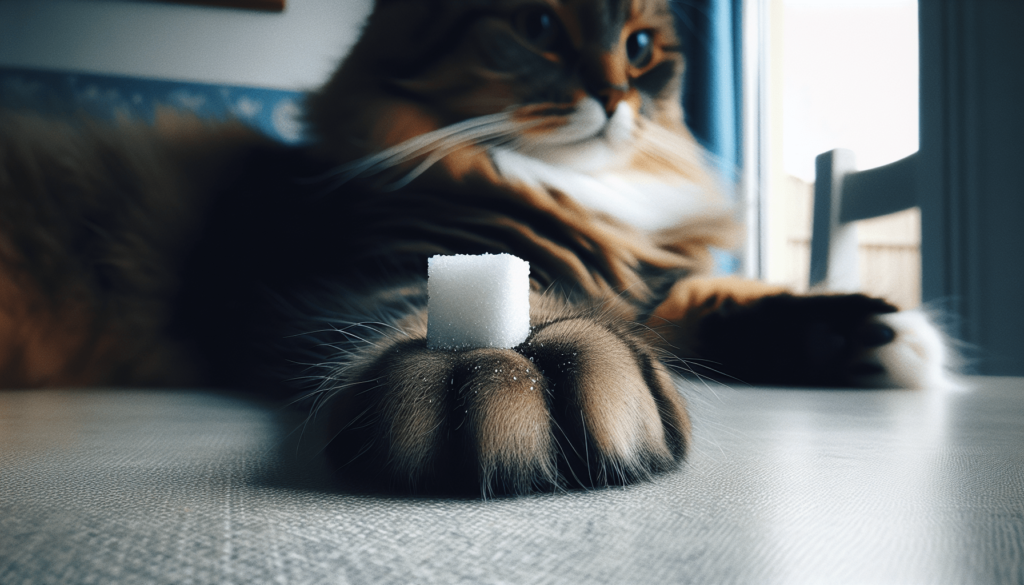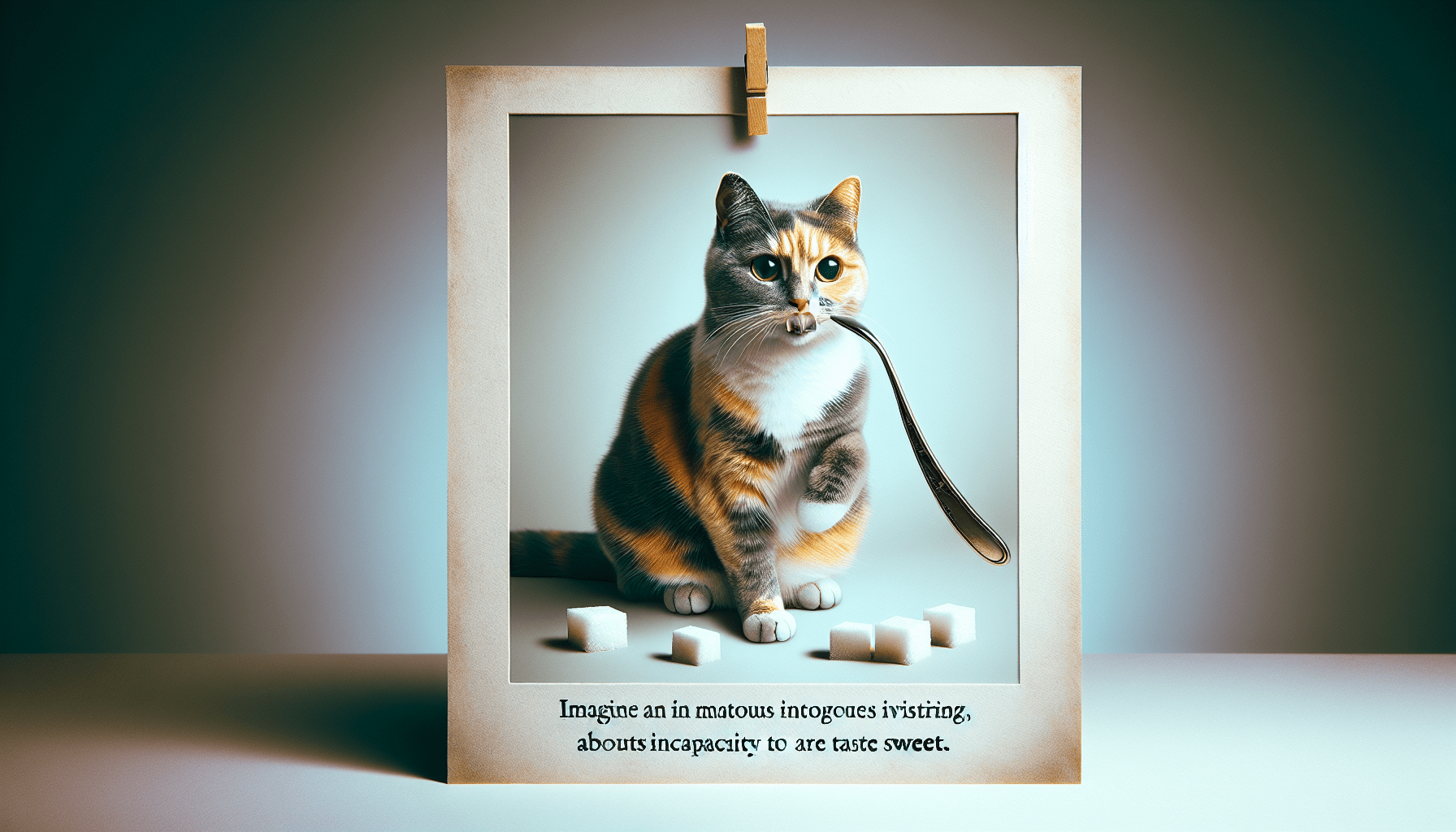Did you ever wonder if cats can taste sweet? It’s a common question for cat owners and curious minds alike. While their taste buds may not be as sensitive to sweetness as ours, cats can still detect some level of sweetness in certain foods. This article will explore the taste perception of cats, shedding light on their unique sensory experiences when it comes to sweetness. Get ready to uncover the fascinating world of feline taste buds!
Understanding Cat Taste Buds
Brief introduction to feline taste buds
Have you ever wondered how your furry feline friend experiences taste? Cats, like humans, have taste buds that enable them to perceive flavors in their food. However, there are significant differences in the way their taste buds function compared to ours. Understanding these distinctions can shed light on why cats have particular dietary preferences and why certain foods may be more appealing to them than others.
Key differences between humans and cats taste buds
Although cats and humans both possess taste buds, their taste preferences vary significantly. One striking difference is that cats lack the ability to taste sweetness. While humans cherish the pleasure of indulging in sugary treats, our feline companions are seemingly indifferent to this flavor. Cats are primarily attracted to flavors that mimic the prey they would typically consume in the wild, such as meat or fish. This disparity in taste perception can be attributed to the unique nature of a cat’s taste receptor genes.
What cats can and cannot taste
While cats cannot appreciate sweetness, they have taste buds that allow them to distinguish between other flavors, including bitterness, sourness, and saltiness. Consequently, they can still appreciate the savory elements present in their diet. This peculiarity may explain why certain flavors, such as fish, can strongly attract and entice cats. Understanding what cats can and cannot taste provides valuable insights into their dietary preferences and helps us make informed choices when choosing their food.
Cats and Sweet Taste Perception
The inability for cats to taste sweet
Unlike humans, cats lack the taste receptor genes necessary to perceive sweetness. While humans possess sweet taste receptor genes TAS1R2 and TAS1R3, these receptors are absent or mutated in the feline genome. As a result, cats are oblivious to the allure of sugary treats that humans find so enjoyable. This biological difference affects not only their preferences but also their nutritional requirements.
Scientific explanation behind why cats cannot taste sweet
The absence of functional sweet taste receptor genes in cats stems from an evolutionary adaptation. Domestic cats are descended from their wild ancestors, who were obligate carnivores and primarily consumed meat. In the wild, sweetness is seldom encountered, and the survival of cats relies on their ability to detect the flavors present in their prey. Over generations, the sweet taste receptor gene in cats became obsolete, as their diet did not contain significant amounts of carbohydrates or sweet substances. This adaptation allowed them to allocate their taste bud resources to better identify and appreciate the flavors present in their prey.

Taste Receptor Genes in Cats
The role of taste receptor genes
Taste receptor genes play a pivotal role in an organism’s ability to perceive and distinguish different flavors. These genes code for the receptors present on taste buds, allowing them to respond to specific flavors. In humans, taste receptor genes enable us to taste a broad range of flavors, including sweetness. However, in the case of cats, taste receptor genes dictate their unique taste preferences and limitations.
Mutation in a cat’s taste receptor genes
The absence of functional sweet taste receptor genes in cats can be attributed to a genetic mutation. Through evolutionary processes, these mutations occurred naturally and selectively in the feline genome, resulting in the loss or alteration of the genes responsible for perceiving sweetness. This mutation allowed cats to develop distinctive taste preferences more suited to their meat-based diet.
Impact of the mutated taste receptor gene on sweet taste
The mutations in the taste receptor genes of cats have the profound effect of rendering them incapable of perceiving sweetness. While other flavors can still be detected, the absence of sweet taste receptors significantly influences their dietary choices and creates a stark contrast to human taste preferences.
Studies on Cats and Sweet Taste
Historical studies
Research on cat taste perception dates back many years, with scientists seeking to explore the intricacies of their unique taste preferences. Early studies confirmed the absence of sweet taste receptors in the feline tongue, suggesting that cats lack the ability to taste sweetness. These early findings set the foundation for further investigations into cat taste perception.
Recent research findings
Recent studies have further solidified the notion that cats cannot taste sweet. Modern techniques, such as genetic analysis and neuroanatomical examinations, have provided a deeper understanding of the molecular and anatomical mechanisms behind taste perception in cats. These advancements have allowed researchers to delve into the specific taste receptor genes involved in feline taste perception, supporting the long-established idea that cats lack the ability to taste sweetness.
Evidence supporting cats’ lack of ability to taste sweet
The evidence supporting cats’ inability to taste sweetness is compelling. Researchers have identified mutations and deletions in cats’ sweet taste receptor genes, offering a molecular explanation for their taste perception limitations. Additionally, behavioral studies conducted on cats have demonstrated their preference for meat-flavored foods, further confirming their aversion to sweetness.

Explaining Cats’ Predatory Nature
Cats as obligate carnivores
To understand cats’ taste preferences, it is crucial to recognize their nature as obligate carnivores. Cats are biologically adapted to consuming a diet composed primarily of meat. Their sharp, pointed teeth and short intestinal tracts are indications of their evolutionary development as efficient hunters and meat eaters. This carnivorous nature has influenced their taste preferences, guiding them towards flavors that closely resemble their prey.
How a cat’s diet influences its taste preferences
The diet of a cat directly impacts its taste preferences. Cats have evolved to prefer flavors associated with the nutrients found in meat, such as protein and fat. Their taste receptors are highly attuned to these flavors, ensuring that they readily identify and enjoy meat-based foods. This preference for specific flavors aligns with their natural dietary requirements and reflects their evolutionary adaptations.
Why cats don’t need to taste sweet
While the inability to taste sweetness may seem limiting to us, cats do not require this ability to thrive. The absence of sweet taste receptors does not hinder their ability to find and consume an appropriate diet. Cats primarily rely on their sense of smell and texture to distinguish and select their food. Additionally, their dietary needs are met through their carnivorous diet, eliminating the necessity for tasting sweet flavors.
Dietary Implications for Cats
The danger of sugary foods for cats
As cats lack the ability to taste sweetness, it is essential to recognize the potential dangers associated with feeding them sugary foods. Cats have a limited ability to metabolize carbohydrates and sugars, making them susceptible to health issues such as obesity and diabetes. Offering cats high-sugar treats or human foods containing excess sugars can lead to weight gain and other detrimental health consequences.
Health risks associated with sweet foods in cats
Feeding cats sweet foods not only poses the risk of weight gain but can also disrupt their delicate balance of nutrients. Cats require a diet that is rich in animal protein and low in carbohydrates, as they lack the necessary enzymes to efficiently metabolize plant-based nutrients. Excessive consumption of sugary foods can lead to imbalances in their nutritional intake and contribute to long-term health issues.
Importance of a balanced cat diet
Maintaining a balanced diet is crucial for the overall health and well-being of cats. A well-formulated cat food should provide all the necessary nutrients in appropriate proportions. Ensuring that their diet is predominantly composed of high-quality animal protein, while minimizing the inclusion of sugars and carbohydrates, is essential for meeting their nutritional requirements and avoiding associated health risks.
Affects of Artificial Sweeteners on Cats
The toxicity of certain artificial sweeteners
While cats may not possess an affinity for sweet flavors, the presence of certain artificial sweeteners can pose significant threats to their health. Substances such as xylitol, commonly found in sugar-free products, are highly toxic to cats and can lead to severe health complications or even fatalities. It is crucial to keep all potentially harmful artificial sweeteners out of reach of cats to prevent accidental ingestion.
Instances of cats poisoned by artificial sweeteners
Tragically, there have been numerous cases of cats suffering from poisoning after ingesting products containing artificial sweeteners. Even small amounts of certain sweeteners can have devastating effects on a cat’s health. Vigilance and responsible handling of products containing artificial sweeteners are imperative to safeguard the well-being of our feline companions.
Symptoms to watch out for if a cat ingests artificial sweeteners
If a cat ingests an artificial sweetener, it is crucial to be vigilant and monitor their behavior for any signs of toxicity. Symptoms of sweetener poisoning in cats can include vomiting, diarrhea, lethargy, seizures, and even liver damage. Should any of these symptoms manifest, immediate veterinary care is necessary to mitigate the potential harm caused by the artificial sweetener.
Cats and Fruits
Can cats taste fruits?
While cats cannot taste sweetness, they still possess taste buds that allow them to perceive other flavors, including those found in fruits. However, it is essential to approach feeding cats fruits with caution, as not all fruits are safe for feline consumption. Some fruits can cause digestive issues or even be toxic to cats.
Fruits that are safe for cats
Certain fruits are safe for cats to eat, but they should be offered in moderation. Examples of cat-friendly fruits include small amounts of sliced apples, bananas, or watermelon. It is crucial to remove any seeds, pits, or peels that can pose choking hazards or contain toxins. Before introducing any new fruit into your cat’s diet, consult with a veterinarian to ensure it is safe and appropriate for their specific needs.
Fruits that are dangerous for cats
There are fruits that should be strictly avoided when it comes to feline consumption. Some fruits, such as grapes and raisins, can be toxic to cats, potentially leading to kidney damage or failure. Other fruits, such as citrus fruits like oranges and lemons, can cause digestive issues and stomach upset. Keeping cats away from these dangerous fruits is vital to their health and well-being.
Myths About Cats and Sweets
Common misconceptions about cats’ taste
There are several common misconceptions regarding cats and their taste preferences. One prevalent myth is that cats love sweets, just like humans. However, as we have learned, cats lack the ability to taste sweetness and are primarily attracted to flavors that mimic their prey. Understanding these misconceptions allows us to better cater to our cats’ dietary needs and preferences.
Debunking myths about cats and sweet foods
While cats may not appreciate the sweetness in foods, this does not mean they cannot enjoy their meals. Feline taste preferences are centered around savory flavors, which can be easily satisfied with high-quality meat-based diets formulated specifically for cats. Providing a nutritionally balanced diet that meets their unique needs ensures their taste preferences are adequately addressed.
How cats can still enjoy food despite their inability to taste sweet
Despite not being able to taste sweetness, cats can derive pleasure from their meals in other ways. Their keen sense of smell allows them to appreciate the enticing aromas of their food, enhancing their overall dining experience. Additionally, the texture and composition of their food play a vital role in their enjoyment, making the inclusion of varied and appealing textures important in their diet.
Future Research Direction
Areas in cat taste research that need further exploration
While much has been discovered about cat taste perception, there are still areas that warrant further research. The molecular mechanisms underlying taste perception in cats remain a subject of interest, as understanding the specific genetic variations responsible for their unique taste preferences can shed light on their evolution and dietary requirements. Additionally, investigating the impact of taste perception on cat feeding behavior and nutritional intake could provide valuable insights into improving feline diets.
Potential breakthroughs and discoveries in future studies
Future research holds the potential for breakthroughs in understanding the intricacies of feline taste perception. The use of advanced molecular techniques and genetic analysis can further illuminate the specific taste receptor genes involved in cat taste perception. Moreover, exploring the neural circuits and brain regions associated with taste and reward in cats may uncover new understandings of their dietary preferences and provide avenues for enhancing their well-being.
How future research could change our understanding of cat taste
Continued research in the field of cat taste perception has the potential to revolutionize our understanding of these fascinating creatures. By uncovering the precise genetic elements governing cat taste preferences, we can gain a more comprehensive understanding of their dietary requirements. This knowledge can inform the development of better-formulated cat foods that align with their natural preferences and nutritional needs, ultimately promoting the health and happiness of our feline companions.
In conclusion, cats’ taste buds provide a unique perspective into their dietary preferences and requirements. While they may not be able to taste sweetness like humans, their carnivorous nature and evolutionary adaptations have shaped their taste preferences. Understanding these distinctions allows us to provide them with nutritionally balanced diets that cater to their needs, promoting their overall well-being. With ongoing research, we can continue to deepen our understanding of cat taste perception and refine our approach to feline nutrition and care.

